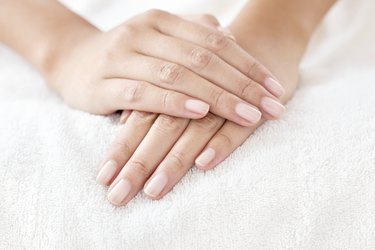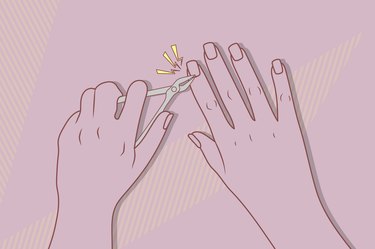
If one day you're walking around normally, then gradually you start to notice painful, inflamed or swollen skin around your toenail, chances are you've got an ingrown toenail.
It's a common condition that happens when a toenail grows into the skin, per the Mayo Clinic.
Video of the Day
Video of the Day
At the very least it can be uncomfortable, but if left untreated, more serious complications like infection may happen.
Here, a dermatologist explains what causes ingrown toenails and weighs in on the most effective home remedies and other treatments.
Symptoms of Ingrown Toenails
The first sign of an ingrown toenail is a tender and swollen toe, says Bruce Robinson, MD, a board-certified dermatologist. The toe may also look red.
As the nail cuts into the skin, the skin grows over the nail and becomes inflamed, he adds.
Other symptoms might include:
- Pus coming out of the toe
- Pain
- Darkening around the affected toe
- Toe feeling warm or hot
Causes
The most common cause of an ingrown toenail is improper grooming habits — namely, cutting the toenail too short, Dr. Robinson says.
"If you cut it too short, it makes it more likely that it's going to grow into the skin," he says. "And when it does that, the skin gets inflamed and swells and actually begins to grow into the nail. So it becomes a very cyclical process."
According to the Cleveland Clinic, other causes include:
- Wearing tight shoes
- Toenail injury
- Nail infections
- Foot shape
Treatment
Ingrown toenails can be treated with self-care at home or by a doctor, depending on the severity, Dr. Robinson says.
"If it's mildly uncomfortable, meaning that you can walk and it's not keeping you up at night, you can treat it at home," he notes.
On the other hand, ingrown toenails may need professional treatment if they've reached the point of infection.
"If it becomes more painful and you have difficulty walking, you see pus or have a fever, then you definitely need to see a dermatologist," Dr. Robinson says.
Home Remedies
DIY treatments for ingrown toenails include the following, per the Cleveland Clinic:
- Take over-the-counter pain relievers to lessen the discomfort.
- Place a cold compress on the toe to reduce the swelling.
- Wear roomy shoes until the ingrown toenail clears up.
- Soak your foot in warm water (but otherwise keep your feet dry).
- Put a piece of cotton or floss in between the nail and skin to help the nail grow above the skin. Use fresh cotton or floss every day.
Medical Treatments
If an ingrown toenail is not improving at home, a doctor can help the healing process.
Don't try to remove an ingrown toenail yourself (no, cutting a 'v' in your nail will not work). Rather, a dermatologist can perform ingrown toenail surgery to partially remove the nail that's ingrown, Dr. Robinson says.
"First we'll numb the area, then cut out that piece of nail that's growing into the skin. So the skin can back off and heal, and the pain goes away," he explains.
If an ingrown toenail becomes infected, a doctor will treat it with antibiotics and possibly drain any pus, Dr. Robinson explains.
Prevention
Keep your feet happy and prevent ingrown toenails with these tips, per the Cleveland Clinic:
- Wear wide toe-box shoes: Avoid tight, improper fitting shoes (which can also lead to brittle toenails).
- Cut toenails properly: Nails should be cut straight across (don't try to round the corners).
- Don't cut nails too short: Keep them even with the tips of your toes.
- Always use a clean nail clipper: Don't share with others.
- Soak toenails in warm water before trimming: This helps soften the nails so they're easier to trim.
When to See a Doctor
If an ingrown toenail is causing you pain that's interfering with how you walk and your day-to-day function, it's time to see a doctor, Dr. Robinson says.
According to the American Academy of Orthopaedic Surgeons, if the toenail is extremely irritated, swollen, painful and has pus coming out of it, it's likely infected and should be treated by a doctor.
FAQ
Common Questions
Do ingrown toenails ever go away?
An ingrown toenail is not likely to go away on its own, Dr. Robinson says. If it's not treated, it can become worse and turn into an infection.
"Unless you get that piece of nail out that's causing the problem, it will likely continue to fester," he says.
What is the fastest way to get rid of an ingrown toenail?
The fastest way to get rid of an ingrown toenail is immediately seeing a doctor. If you don't want to wait and see if home remedies work, a minor procedure can be done to remove the nail that's grown into the skin, Dr. Robinson explains.
Why do I keep getting ingrown toenails on my big toe?
If an ingrown toenail just keeps coming back, it could be from improper grooming or the shoes you're wearing.
"It's often due to cutting the nail too close or even wearing shoes that are too tight," Dr. Robinson says. "Shoes that shove your foot in a tight, closed space oftentimes will produce an ingrown toenail."
Recurring ingrown toenails can also occur from trauma, including sports, where there's a lot of stopping and starting, like tennis. "The movement shoves your foot into the narrow part of the shoe," Dr. Robinson explains.
Was this article helpful?
150 Characters Max
0/150
Thank you for sharing!
Thank you for your feedback!
Is this an emergency? If you are experiencing serious medical symptoms, please see the National Library of Medicine’s list of signs you need emergency medical attention or call 911.


